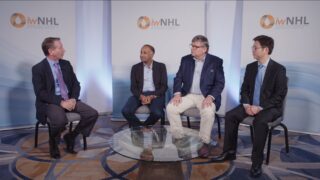So historically the management of mantle cell lymphoma at least in the front line is kind of dichotomized based on age and fitness. For younger and fit patients the goal is to get them to high-dose R-CHOP containing intensive induction followed by transplant and maintenance therapy while in the older patients the challenge is that they cannot tolerate such high dose therapy regimen including high-dose R-CHOP and transplant...
So historically the management of mantle cell lymphoma at least in the front line is kind of dichotomized based on age and fitness. For younger and fit patients the goal is to get them to high-dose R-CHOP containing intensive induction followed by transplant and maintenance therapy while in the older patients the challenge is that they cannot tolerate such high dose therapy regimen including high-dose R-CHOP and transplant. So usually they get bendamustine-rituximab induction therapy followed by rituximab maintenance. Now with the frontline treatment landscape roughly evolving, now we incorporate novel agents into the frontline therapy. For younger patients now we combine a BTK inhibitor with the high-dose R-CHOP and then induction therapy. With that induction, the TRIANGLE trial really showed that we probably can skip transplant for the younger patients. And then they will go on to receive BTK inhibitor and rituximab maintenance. But again, with this involvement, the older patients are still not eligible because of the high-dose R-CHOP part. The development in this population now is also to include the BTK inhibitor, now in combination with the BR regimen and maintenance. The ECHO trial showed the addition of acalabrutinib indefinite therapy plus the BR and R maintenance therapy really improves the progression-free survival very clearly. And there was also a trend of improving the overall survival pending longer follow-up. So although the challenge is really these patients cannot tolerate chemotherapy, now with the addition of BTK inhibitor, we hope to improve their outcomes. In the relapsed setting, it used to be BTK inhibitor as the preferred second line, but with the evolving frontline treatment incorporating a BTK inhibitor, second line is probably looking at earlier use of CAR-T. So for the older population, now that we are incorporating ibrutinib in the front line together with BR, in the second line setting, we really try to use CAR-T early. Good news is that there’s not really an age cutoff for CAR-T therapy, so most of the patients are still eligible from an age standpoint. That’s really comes down to disease control and their fitness in terms of performance status and all that. control to improve their performance status and once again despite of age we can take most of the patients to CAR-T.
This transcript is AI-generated. While we strive for accuracy, please verify this copy with the video.















